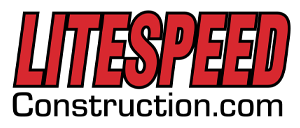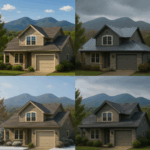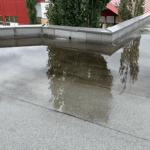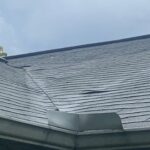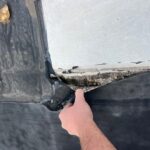Who’s Responsible if a Neighbor’s Tree Damages My Roof?
Homeowners are often caught off guard by the legal and financial ramifications when a tree from a neighboring yard falls and damages their property.
Particularly in areas like Asheville, NC, where storms and high winds are common, understanding property rights and insurance nuances around tree-related damages is essential.
This article explores the responsibilities of homeowners and neighbors, the role of insurance, and the steps you can take to prevent and handle these unexpected situations.
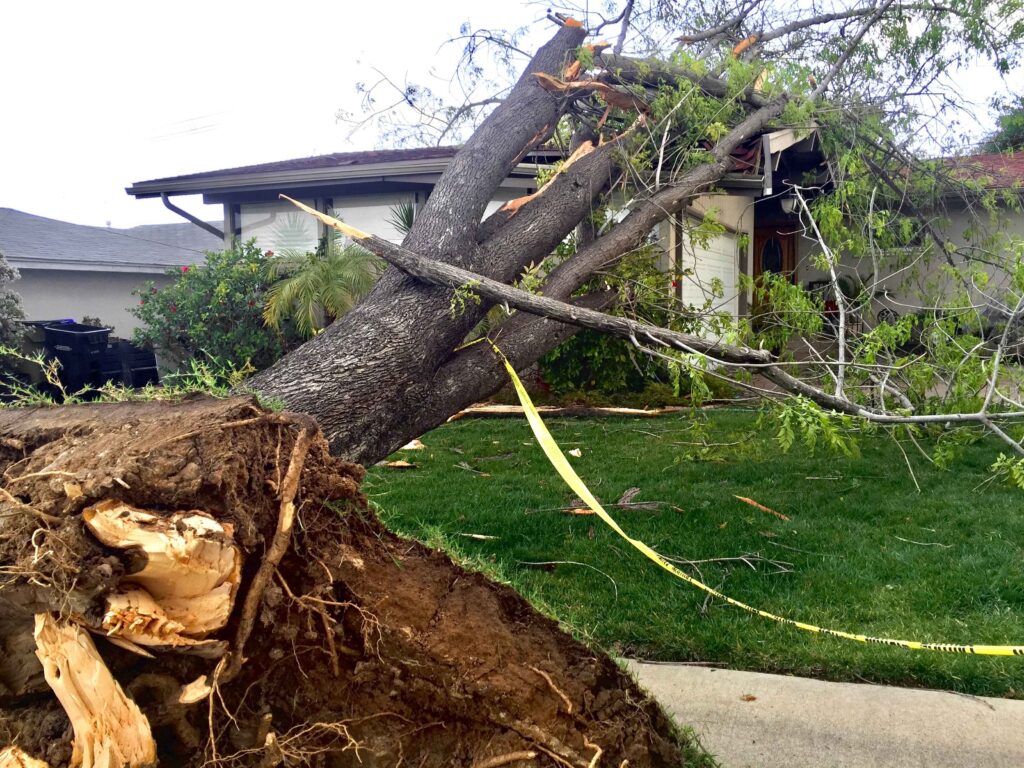
Property Rights and Tree Damage
The legalities surrounding tree ownership and damage vary significantly by state. However, one general rule in U.S. property law is that the tree owner is typically responsible for the tree’s health, while the property owner affected by a fallen tree is responsible for managing the tree once it crosses their boundary. This means:
– If a healthy tree on your neighbor’s property falls due to a natural event (e.g., a storm), they may not be liable.
– If a dead, diseased, or otherwise neglected tree falls onto your property, your neighbor might be liable.
In Asheville, where seasonal weather patterns can cause property damage, it’s essential for property owners to know their responsibilities to mitigate these risks.
Factors Influencing Responsibility in Tree Damage Cases
Several factors impact who is held responsible when a tree falls from one property to another, causing damage:
1. Condition of the Tree Before It Fell
Courts often evaluate whether the tree was healthy or if negligence (e.g., failure to trim or remove a dead tree) was involved. According to North Carolina law, property owners are responsible for maintaining the trees on their property, especially if they are visibly unhealthy and pose a hazard.
2. Cause of the Tree’s Fall
Natural events like strong storms, heavy snowfall, or hurricanes can uproot trees, even healthy ones. In cases like these, where nature is the primary cause, neither the tree owner nor the affected neighbor is typically considered at fault. This rule, however, may not apply if the tree’s condition was already compromised due to negligence.
3. Local Tree Ordinances and Insurance
Many cities, including Asheville, have specific ordinances that address tree maintenance and responsibility. For instance, if a tree is deemed hazardous by the city and not dealt with, the property owner may face fines and liability if the tree eventually causes damage.
The Role of Insurance: What Coverage Applies?
Homeowners insurance is crucial when it comes to damage from falling trees. Here’s a look at how typical policies handle tree-related damages:
Homeowner’s Insurance: Most homeowners’ insurance policies cover damage to a property if a tree falls due to a covered peril, like wind, hail, or snow. The policy may cover the cost of removing the fallen tree from the property, but coverage limits may apply.
Liability Coverage: If a neighbor’s tree damages your home and negligence is proven (e.g., the tree was diseased and left untreated), you may be able to claim liability coverage from the neighbor’s homeowner’s policy.
Negligence Considerations: Insurance companies may consider negligence when a neighbor’s tree falls on your property. For example, if a neighbor ignored multiple warnings to remove or trim a decaying tree, they might be held liable for damages.
Key Statistics on Tree Damage and Home Insurance
| Statistic | Figure |
|---|---|
| Average Cost of Tree Removal (U.S.) | $400 - $1,200 |
| Average Cost of Roof Repair (for moderate tree damage) | $1,000 - $3,000 |
| Percentage of Homeowners with Insurance Coverage for Tree Damage | 80% |
| Average Insurance Deductible for Tree Damage Claims | $500 - $1,500 |
| Number of Tree Damage Claims Filed Annually in the U.S. | ~10,000 claims |
These figures underscore the importance of being insured and understanding policy details, as the costs associated with tree damage can be significant.
Steps to Take if a Tree from Your Neighbor’s Yard Damages Your Roof
1. Document the Damage
Start by photographing the damage from multiple angles and take notes on the extent of the harm. This documentation will be invaluable for both insurance claims and potential legal action.
2. Contact Your Insurance Company
Immediately reach out to your homeowner’s insurance provider. In cases where negligence may be a factor, your insurer might pursue a subrogation claim to recover costs from your neighbor’s insurance.
3. Engage a Qualified Roofing Inspector
Having a roofing expert assess the damage ensures that all repair needs are accurately identified. For Asheville residents, it’s wise to hire a local roofing company familiar with North Carolina’s building codes and weather patterns.
4. Communicate with Your Neighbor
Open communication with your neighbor is essential, as it can often resolve issues more amicably. Inform them of the incident and provide them with any relevant documentation from the roofing company or insurance.
How to Prevent Tree-Related Roof Damage
Preventative steps can significantly reduce the risk of tree-related roof damage:
Tree Maintenance: Regular pruning and inspection are essential. Property owners are encouraged to assess the health of trees near their homes, especially those near their roofline.
Weatherproofing Your Roof: Investing in a quality roof and ensuring regular inspections are essential. Asheville’s climate can wear down roofing materials over time, making them more susceptible to damage from falling debris.
Communication with Neighbors: If a neighboring tree appears unhealthy, communicate your concerns. A polite conversation about safety risks can go a long way.
Legal Recourse in Cases of Neighbor Negligence
If a neighbor fails to address a dangerous tree and it falls, damaging your property, legal action might be an option. In North Carolina, proving negligence generally requires evidence that the tree was visibly diseased or hazardous. Here are some steps to follow:
1. Document the Tree’s Condition: Keep records of any visible signs of disease or decay, as well as any communication with your neighbor about the potential hazard.
2. Consult a Lawyer: A local property attorney can advise you on whether you have grounds to pursue damages.
3. Mediation and Small Claims Court: In many cases, mediation can resolve the issue without a lengthy legal battle. Small claims court is another avenue for homeowners seeking compensation for repair costs.
FAQs about Tree Damage
Document the damage, contact your insurance company, and discuss the incident with your neighbor.
Most policies cover damage if caused by a natural event; however, deductibles and limits apply.
If negligence is proven, your neighbor could be liable. Documentation and inspection are key.
If liability is disputed, legal consultation can help determine if small claims court is appropriate.
Regular tree trimming, roof inspections, and clear communication with neighbors can help.
Only if they are proven negligent; otherwise, your insurance usually covers the costs.
Signs include dead branches, fungal growth, and visible decay. Consulting an arborist can provide a professional assessment.
Yes, North Carolina property law may hold owners accountable for neglecting dangerous trees.
In cases of extensive damage, each affected property owner should file separate insurance claims.
Costs vary by damage extent but can range from $500 to $3,000 after insurance deductibles.
Tree-related Damage
In Asheville, NC, and beyond, understanding the complexities of tree-related damage and homeowner liability is essential for protecting your home and finances. Taking preventative measures and staying informed about property law and insurance coverage can help homeowners minimize risk. When in doubt, consult a roofing professional and discuss tree maintenance and potential hazards with neighbors to create a safer, more informed community.
